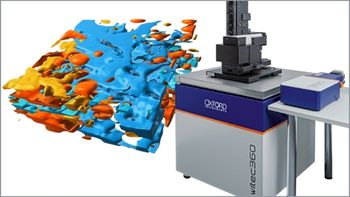
Spectroscopy in Biopharmaceutical Analysis
**Available On Demand** What are the current capabilities of spectroscopic techniques in biopharmaceutical development and processing? What capabilities can we foresee in the near future? Join us for this insightful two-day virtual symposium—presented jointly by Spectroscopy, BioPharm International, the Society for Applied Spectroscopy, and the Coblentz Society—to get the answers to these questions and more.
Register Free:
Event Overview:
What are the current capabilities of spectroscopic techniques in biopharmaceutical processing? What is the current state of implementation of these techniques? What capabilities can we foresee in the near future? What is practical and what is still a dream? Join us for this insightful two-day virtual symposium—presented jointly by Spectroscopy, BioPharm International, the Society for Applied Spectroscopy, and the Coblentz Society—to get the answers to these questions and more, as we look at the application of a range of spectroscopic techniques to different aspects of upstream and downstream processing in the biopharmaceutical industry. And ask your own questions during the live question-and-answer sessions with the speakers.
Key Learning Objectives:
- The current capabilities of spectroscopic techniques for upstream and downstream applications in biopharmaceutical development and processing?
- Practical advice for real-world application of spectroscopy techniques in the biopharmaceutical industry—gleaned from real implementation examples
- A vision for what capabilities can we foresee in the near future
Who Should Attend:
- Scientists and managers working in biopharmaceutical process development, manufacturing, and quality operations, analytical departments, process analytical technologies (PAT) and related roles
Schedule:
Day 1, Session 1: Spectroscopy in Upstream Processing
10–10:30am EDT
Building Robust Raman Identification Methods for Media Powder
Jessica Mondia, Technical Lead, Quality Control, and Senior Manager, Material Sciences, Bristol-Myers Squibb Company
Chemically defined powders used for cell culture media are composed of multiple nutrient-rich ingredients including amino acids, vitamins, metals, salts, sugars, and other growth-promoting components. Biopharmaceutical companies invest significant effort in developing the best formulations of ingredients, which are continuously being updated to optimize performance of existing and next-generation biopharmaceutical therapeutics. An associated challenge is the ability to easily and rapidly differentiate multiple powdered media from each other through identification testing. A promising method employed is identification by Raman spectroscopy using portable devices that are small, robust, and easy to operate. The Raman identification (ID) tests are performed by scanning the material of interest and matching the measured Raman spectrum to a library of reference spectra. This presentation will explore the limitations and benefits of handheld Raman spectrometers, risks associated with using Raman spectroscopy for identification of media powders, and mitigation strategies to ensure robust instrument library lifecycle management.
10:30–11am EDT
Using Multidimensional Fluorescence Spectroscopy with Chemometric Data Analysis in Upstream Processing of Biopharmaceuticals: Routine Screening of Raw Materials & Cell Culture Media
Alan G. Ryder, Professor and Principal Investigator, Nanoscale Biophotonics Laboratory, School of Chemistry, National University of Ireland-Galway
Multi-dimensional fluorescence spectroscopy (MDFS) offers a convenient and inexpensive approach for the rapid and routine analysis of cell culture media and complex hydrolysates. MDFS provides information about both changes in media composition (lot-to-lot variance) and the presence of particulate matter, both of which can be critical for quality control and assurance purposes. MDFS and multivariate analysis can be used for lot-to-lot variance analysis, process (filtering, sterilization, storage) validation, and in some cases as a predictive process model. Here we describe multiple case studies and show how MDFS can be effectively implemented for routine, quality control screening of media.
11–11:30am EDT
Fluorescence Fingerprinting to Support All Stages of the Cell Culture Media Lifetime
Amandine Calvet (scientist), Andreas Unsoeld (laboratory head), Jochen Schaub (group head) all in Bioprocess Development Biologics, Late stage USP development, Boehringer Ingelheim, Biberach, Germany
From development to commercial production, fluorescence fingerprinting can support activities across the entire lifetime of the cell culture media applications. In this presentation we would like to show how spectroscopy, and specifically fluorescence fingerprinting, can be used to support various activities such as media development, media preparation monitoring, and root-cause analysis. We will also look toward the future of fluorescence fingerprinting in biopharma as a potential tool for raw material incoming testing.
11:30am –12pm EDT
The Role of Raman Spectroscopy in Vaccine Manufacturing
Karin Balss, Scientific Fellow, Janssen Pharmaceuticals
Vaccines are now frequently manufactured in single use or stainless-steel bioreactors, analogous to those used in monoclonal antibody production. To meet large, global demand, the manufacturing of vaccines must be robust, scale-able, and transferrable to multiple manufacturing locations. Modeling and process analytical technology (PAT) sensors have shown value in other cell cultivation processes, such as those for monoclonal antibodies, for real-time fault monitoring and correction, predictive quality, optimizing yield, and improving process robustness. Raman spectroscopy sensing in production bioreactors provides real time information about nutrient feed, metabolites, biomass, and product yield. The technique is highly chemically specific and scalable from the laboratory to commercial scale and represents an all-inclusive chemical fingerprint of the bioreactor. This talk will highlight a few examples using Raman spectroscopy sensing and multivariate modeling for monitoring vaccine production. Using smart, multiplexed sensors with modeling in this way reduces risk of scale-up and technical transfers. We can see process faults in real time, advise on parameters to adjust, and have the immediate ability to compare batch evolution with historical batches. We anticipate that over time, the models will become performance- and quality-indicating and allow for easy comparisons of the process at each site and across scales.
12–12:30pm EDT
Question and Answer Session
All Speakers From Session
Day 1, Session 2: Vendor Presentations
Day 2, Session 2 : Spectroscopy in Downstream Processing
10–10:30am EDT
Role of Spectroscopy for Monitoring and Control of Bioprocesses
Anurag S. Rathore, Coordinator, DBT Center of Excellence for Biopharmaceutical Technology, and Professor, Department of Chemical Engineering, Indian Institute of Technology (IIT), New Delhi, India
Monitoring and control of biotech processes is non-trivial. Most unit operations are complex and have non-linear dynamics, which makes them difficult to model, monitor, and control. An optimal control scheme involves several critical elements, namely a process model, a robust control scheme, and an analytical method. This presentation will focus on the latter, the role played by the analytical method, in particular spectroscopic tools. Multiple case studies, focusing on downstream processing, will be presented to elucidate the key concepts. Each case study will demonstrate how clever selection of analytical tool—such as near-infrared (NIR), Raman, or Fourier transform IR (FT-IR) spectroscopy—can play a key role in delivering process analytical technology (PAT) and creating “a system for designing, analyzing, and controlling manufacturing through timely measurements (during processing) of critical quality and performance attributes of raw and in-process materials and processes, with the goal of ensuring final product quality.”
10:30–11am EDT
FT-IR Monitoring of Protein Drug Product Unit Operations
Greg Lane, Senior Research Investigator, Engineering Technologies, Drug Product Development, Bristol-Myers Squibb Company
There has been a growing trend of applying process analytical technologies (PAT) to the biologics space over the past 10-15 years. While monitoring of upstream processes with Raman spectroscopy in particular has frequently been cited in the literature, downstream processing, including drug product formulation, has also seen a revolution in real-time PAT applications. As more processes move to higher-concentration unit operations, the ability and need to monitor them in real time is further enhanced by the use of spectroscopy. Monitoring of protein and excipient concentrations with Fourier transform infrared (FT-IR) spectroscopy is described in this talk. Aqueous solutions, and the resulting high absorbance of water in the FT-IR region, have traditionally been thought of as challenges for the application of FT-IR spectroscopy. However, the use of attenuated total reflection (ATR) windows ensures that short, fixed pathlengths are achieved, which in turn demonstrates that FT-IR is ideally suited for high-concentration protein and excipient solutions. The ability to see how buffers are exchanged and how proteins impact excipient concentrations provides insights into unit operations that would otherwise be challenging by sampling and off-line analysis. This talk also describes the model-building process for protein and excipient analytes so their concentrations can be trended and monitored in real time. Models can be based off of simple, single-point calibrations or more elaborate partial least squares (PLS) models can be constructed in various modeling packages. Both approaches allow scientists to monitor the process in real time and gain insights into the performance of the unit operations.
11–11:30 am EDT
Analytical Challenges Associated with Protein Formulation at Low and High Concentrations
Jennifer McManus, Associate Professor, School of Physics, University of Bristol, UK
Biomolecules, including proteins and peptides, are complex molecules and it is often difficult to predict or control their stability, leading to challenges in manufacture, during formulation, and in storage. One significant degradation pathway is protein self-association or aggregation, which can be promoted by protein-specific characteristics, by interactions between proteins mediated by changes in solution conditions, or through interactions with surfaces. Understanding complex protein-protein interactions is essential to revealing the mechanisms underlying protein self-association and aggregation. Measuring aggregation also presents an analytical challenge, particularly when reversible self-association at high protein concentration occurs, because fewer analytical techniques are available to characterize protein assemblies in these conditions. Using some case studies for model proteins and IgG1, I will present our recent work on understanding protein-protein interactions and on the characterization of protein assemblies in high concentration solutions and show that using different techniques, we can robustly determine both assembly size and abundance across a range of solution conditions.
11:30am–12:30pm EDT
Question and Answer Session
All Speakers From Session
Register Free:
Newsletter
Get essential updates on the latest spectroscopy technologies, regulatory standards, and best practices—subscribe today to Spectroscopy.





